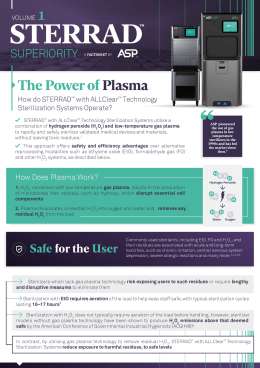STERRAD™ Systems use a combination of hydrogen peroxide (H2O2) and low-temperature gas plasma to produce microbicidal free radicals, which work to sterilize medical devices and instruments by disrupting essential cell components.1, 2 The gas plasma dissociates any unreacted H2O2 into oxygen and water, removing any residual H2O2 from the load being sterilized.2
STERRAD™ Systems offer:
Safety for the User
Safety for the Patient
The advanced low-temperature gas plasma technology delivers rapid and safe sterilization, helping to ensure that medical and surgical instruments are reprocessed in line with the relevant guidelines, thereby potentially mitigating the risk of healthcare-associated infections.2, 4, 5
Unlike other commonly used sterilization systems, which have been shown to leave toxic residues on medical devices,6, 7 STERRAD™ Systems ensure safety for the patient by removing residual H2O2 during the plasma phase.2
As a result, thanks to the plasma technology, sterilization with STERRAD™ Systems does not require aeration of the load before handling, minimising lengthy instrument turnover times and helping to reduce delays to operating schedules which compromise patient safety.3
Safety for the Environment
References
Advanced Sterilization Products. STERRAD™ 100NX System with ALLClear™ Technology User Guide. A11150401-50.
Advanced Sterilization Products. STERRAD™ Superiority Factsheet Volume 1 - The Power of Plasma. AD-200071-01-CT_B-MDR.
Advanced Sterilization Products. Comparison Study of Environmental Hydrogen Peroxide Levels of STERRAD™ Systems and STERIS V-PRO™ Low Temperature Sterilizers Reveals Striking Differences. 2016, AD-180020-01-CT_B-MDR
Rutala WA, Gergen MF, Sickbert-Bennett EE, et al. Comparative evaluation of the microbicidal activity of low-temperature sterilization technologies to steam sterilization. Infect Control Hosp Epidemiol 2020;41:391-395. AD-200041-01-CT_A
Centers for Disease Control and Prevention. Guideline for Disinfection and Sterilization in Healthcare Facilities. Low-Temperature Sterilization Technologies. 2008.
World Health Organisation. Ethylene Oxide International Chemical Assessment Document. 2003.
Ari S, Caca I, Sahin A, et al. Toxic anterior segment syndrome subsequent to pediatric cataract surgery. Cutan Ocul Toxicol 2012;31:53-7.
McIsaac DI, Abdulla K, Yang H, et al. Association of delay of urgent or emergency surgery with mortality and use of health care resources: a propensity score-matched observational cohort study. Cmaj 2017;189:E905-e912.

